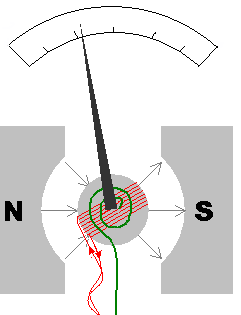Ammeter
|
|
An ammeter is a measuring instrument used to measure the flow of electric current in a circuit. Electric currents are measured in amperes, hence the name. The word "ammeter" is commonly misspelled or mispronounced as "ampmeter" by some.
The earliest design is the D'Arsonval galvanometer. It uses magnetic deflection, where current passing through a coil causes the coil to move in a magnetic field. The voltage drop across the coil is kept to a minimum to minimize resistance in any circuit into which the meter is inserted.
A galvanometer can burn out if its tiny, delicate coil overheats. To measure larger currents, a resistor called a shunt is placed in parallel with the coil. Most of the current flows through the shunt, and only a small fraction flows through the meter. With this solution, arbitrarily large currents can be measured with a single meter. Traditionally, the meter used with a shunt reaches full-scale deflection when a voltage of 50mV is placed across its coil, so shunts are typically designed to produce a voltage drop of 50mV when carrying their full rated current.
Cruder ammeters simply use a moving piece of iron (or a magnet) that is acted-upon by the electromagnetic force of fixed coil of (usually heavy gauge wire. At very high current ratings, such an ammeter can actually just clamp on to an existing conductor (where the conductor acts as a single-turn coil); this later example is sometimes used in automotive applications where it clamps-on to the main battery wire to show the charging and discharging of the battery.
More modern ammeter designs use an analog to digital converter to measure the voltage across the shunt resistor. The ADC is read by a microcomputer that performs the calculations to display the current through the resistor.
One problem with the use of an ammeter is the need for the meter to be inserted into the circuit and become part of it. In AC circuits, an inductive coupling adapter converts the magnetic field around a conductor into a small AC current that can be easily read by a meter. See clamp meter. In a similar way, accurate DC non-contact ammeters have been constructed using Hall effect magnetic field sensors.
See also
- Clamp meter
- Electronic test equipment
- Electronics
- List of electronics topics
- Measuring instrument
- Meter (electronics)
- Multimeter
- Series and parallel circuits
- Voltmeterca:Amperímetre
da:Amperemeter de:Strommesser es:Amperímetro fr:Ampčremčtre nl:Ampčremeter ja:電流計 pl:Amperomierz pt:Amperímetro sl:Ampermeter

